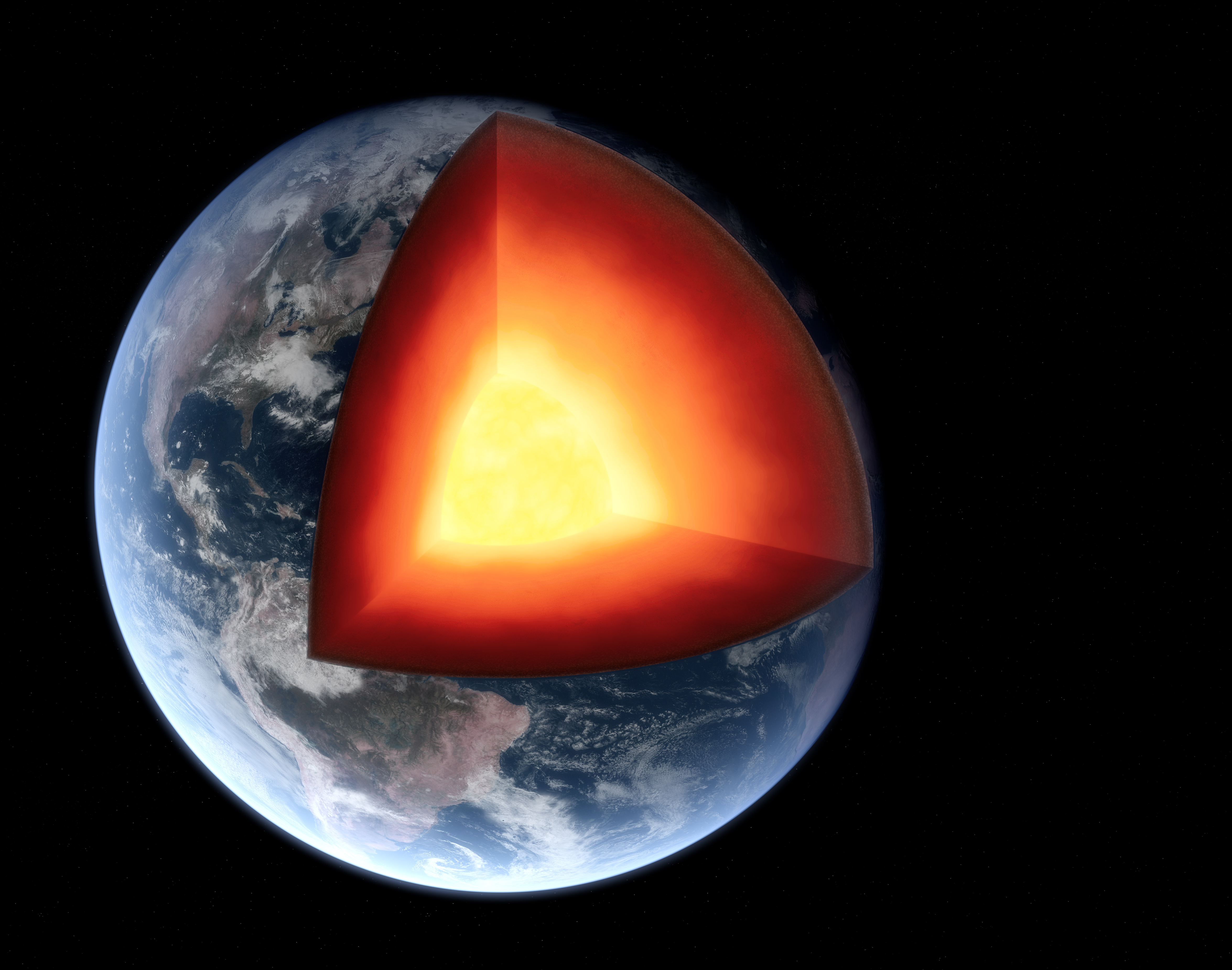What's at the center of the Earth?
Researchers think they've found the 'innermost inner core'


New research sheds light on the Earth's "innermost inner core," offering new insight into the formation of the planet and its magnetic field.
Like an onion, the Earth has layers. The scientific community knows about four such layers: The outer crust is the thinnest layer, and it is where we live. Below that is the thick mantle, which makes up 84 percent of Earth's volume and acts as a transition zone between the outside and inside of the planet. Deeper down are the outer core, which is made up of liquified metals including iron and nickel, and the inner core, which is the center-most layer made up of a number of metals. The inner core is dense and solid.
The new study, published in the journal Nature Communications, finds there is a fifth layer, deemed the "innermost inner core," and that it is a solid ball made up of mostly iron, reports CNN. "The monumental finding" could unlock "some of the oldest mysteries about our planet," the news site says.
The Week
Escape your echo chamber. Get the facts behind the news, plus analysis from multiple perspectives.

Sign up for The Week's Free Newsletters
From our morning news briefing to a weekly Good News Newsletter, get the best of The Week delivered directly to your inbox.
From our morning news briefing to a weekly Good News Newsletter, get the best of The Week delivered directly to your inbox.
How was the fifth layer discovered?
Researchers had long suspected the Earth had another layer at its core, but because its composition is so similar to the layer surrounding it, the innermost inner core was hard to spot. "The transition from the innermost (solid) ball to the outer shell of the inner core (also solid shell) seems rather gradational than sharp," explains study coauthor Dr. Thanh-Son Phạm.
Because scientists can't actually see the center of the Earth, they used data from seismic waves created by earthquakes to analyze its composition. "They found the innermost inner core changed the speed of those waves in a different way than the layer above it, the center core's outer shell," CNN says.
"For the first time, we report observations of seismic waves originating from powerful earthquakes traveling back and forth from one side of the globe to the other up to five times like a ricochet," Pham says.
Why is the finding significant?
The inner core "is a time capsule of our planet's history," the authors write. Its solidification causes convection in the outer core. Convection is "the engine that powers the dynamo that converts kinetic energy into magnetic energy and maintains Earth's global magnetic field," ScienceAlert explains. "That magnetic field is thought to keep harmful radiation out, and the atmosphere in, allowing life to thrive." Therefore, any changes within Earth's core could substantially affect life on Earth. "Probing the innermost part of the [inner core] is critical to further disentangling the time capsule and understanding Earth's evolution in the distant past," the study's authors conclude.
A free daily email with the biggest news stories of the day – and the best features from TheWeek.com
Understanding the makeup of the core could paint a picture of how the planet's magnetic field developed and how it could potentially change in the future. The latest discovery follows on the heels of research showing the inner core has "paused" its rotation, and may be in the process of changing its direction. This is another factor that could impact the Earth's magnetic field.
The discovery of the innermost inner core "gives us a glimpse of what might have happened with other planets," Pham remarks. "Take Mars as an example. We don't understand yet why (Mars' magnetic field) ceased to exist in the past."
Devika Rao has worked as a staff writer at The Week since 2022, covering science, the environment, climate and business. She previously worked as a policy associate for a nonprofit organization advocating for environmental action from a business perspective.
-
 US citizens are carrying passports amid ICE fears
US citizens are carrying passports amid ICE fearsThe Explainer ‘You do what you have to do to avoid problems,’ one person told The Guardian
-
 All roads to Ukraine-Russia peace run through Donetsk
All roads to Ukraine-Russia peace run through DonetskIN THE SPOTLIGHT Volodymyr Zelenskyy is floating a major concession on one of the thorniest issues in the complex negotiations between Ukraine and Russia
-
 Why is Trump killing off clean energy?
Why is Trump killing off clean energy?Today's Big Question The president halts offshore wind farm construction
-
 5 recent breakthroughs in biology
5 recent breakthroughs in biologyIn depth From ancient bacteria, to modern cures, to future research
-
 Blue Origin launches Mars probes in NASA debut
Blue Origin launches Mars probes in NASA debutSpeed Read The New Glenn rocket is carrying small twin spacecraft toward Mars as part of NASA’s Escapade mission
-
 ‘The Big Crunch’: why science is divided over the future of the universe
‘The Big Crunch’: why science is divided over the future of the universeThe Explainer New study upends the prevailing theory about dark matter and says it is weakening
-
 The moon is rusting
The moon is rustingUnder the radar The Earth is likely to blame
-
 Panspermia: the theory that life was sent to Earth by aliens
Panspermia: the theory that life was sent to Earth by aliensUnder The Radar New findings have resurfaced an old, controversial idea
-
 Africa could become the next frontier for space programs
Africa could become the next frontier for space programsThe Explainer China and the US are both working on space applications for Africa
-
 Hurricanes are not exclusive to Earth. They can happen in space.
Hurricanes are not exclusive to Earth. They can happen in space.Under the radar These storms may cause navigational problems
-
 Answers to how life on Earth began could be stuck on Mars
Answers to how life on Earth began could be stuck on MarsUnder the Radar Donald Trump plans to scrap Nasa's Mars Sample Return mission – stranding test tubes on the Red Planet and ceding potentially valuable information to China
